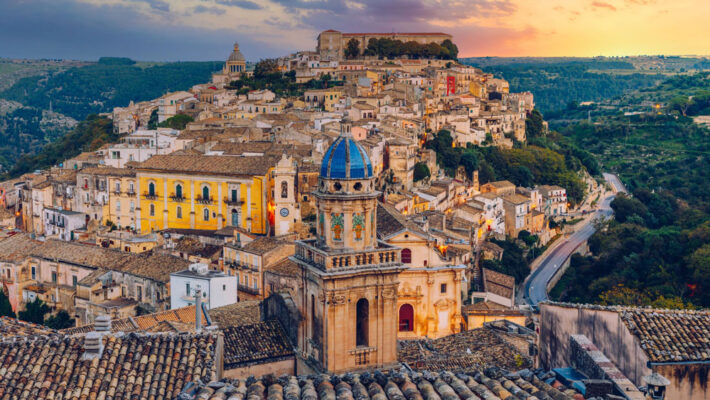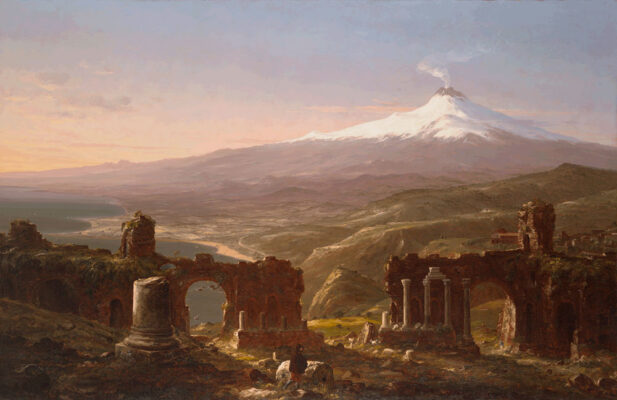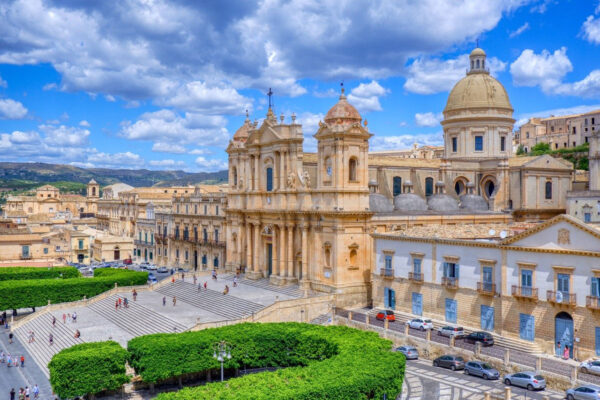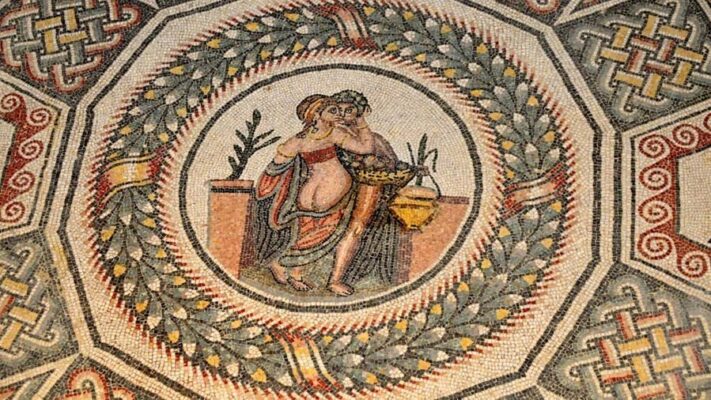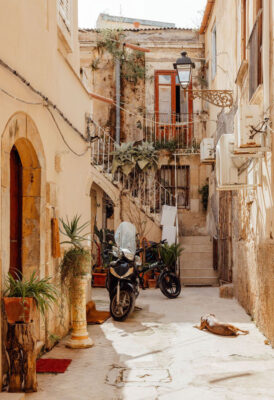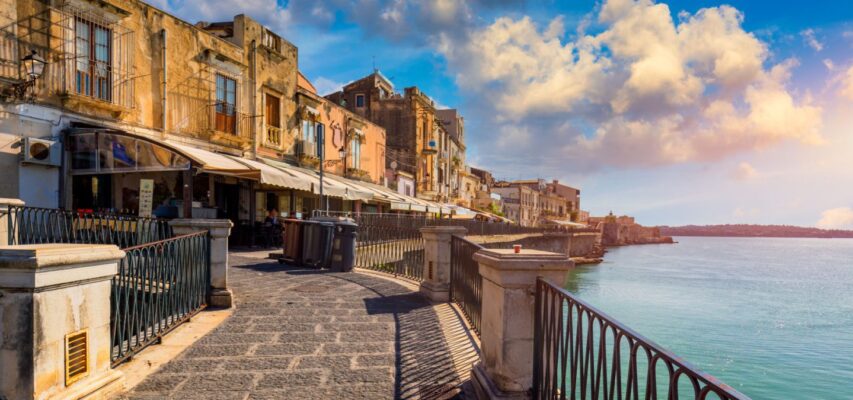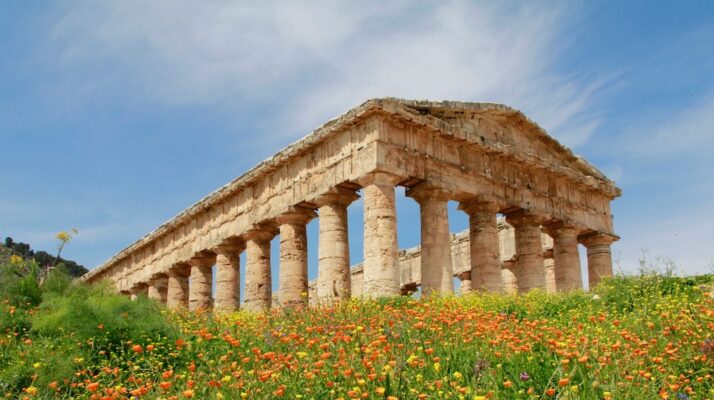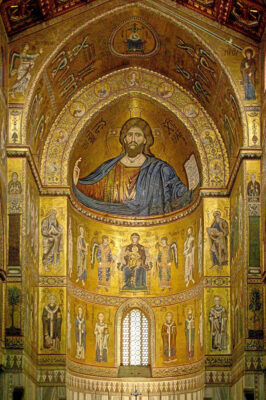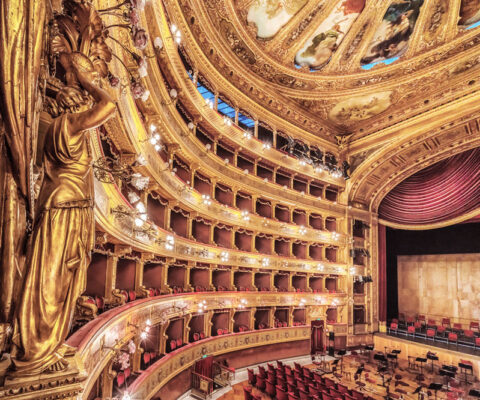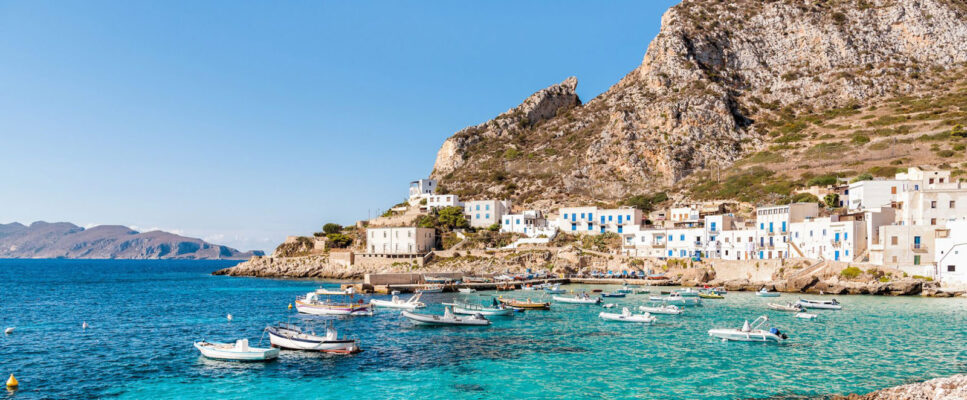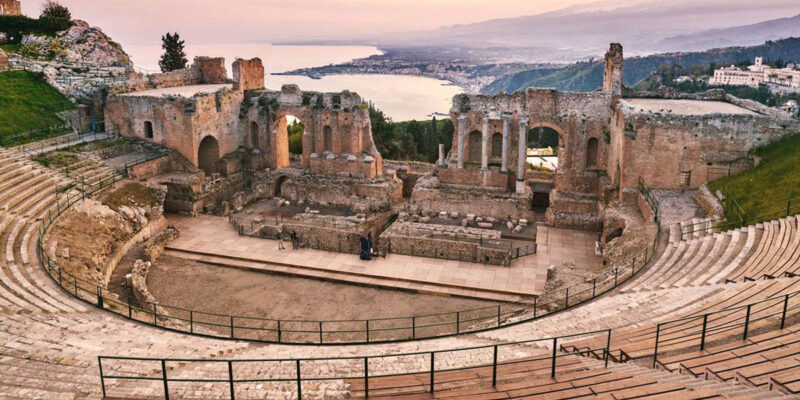Wonders of Sicily
11-day Cultural Program (overland travel)
Archeology, architecture, mountains, sea towns, Baroque churches, vineyards, artisans, monasteries, opera, and more!
March 23rd - April 2nd, 2026 Registration: SOLD OUT (Max 14 participants). Waitlist started.
April 3rd - 13th, 2026 Registration: SOLD OUT (Max 14 participants). Waitlist started.
March 22nd - April 1st, 2027
Please join us to discover the Wonders of Sicily! This year our program coincides with the Palm Sunday service celebrations in the historic churches of Palermo, not to be missed! Our cultural tour offers a chance to experience one of the world's premier destinations through the lens of our trademark tour priorities: excellence in organization and thematic content that makes every day more thrilling than the previous. This cultural tour gives a broad introduction to the most important sites as well as the wealth of artistic culture that flourishes in Sicily today. We combine both sophisticated lectures on history, and exciting interactions with present-day Sicilians and daily life. We explore the Greek and Roman legacy of the island, the Phoenician and Trojan and Norman influences, the Catholic impact on architecture and culture, all while enjoying the magic of authentic towns along Sicily's famous coastline. Traditional music is always a part of every John Graham tour! Many of our guests who have enjoyed tours in Georgia, Armenia, and Turkey will love this tour. For new visitors to our company, please see our review page to get a sense of why our small group tours are so popular!
Details:
- Arrive-Depart Catania (airport designation CTA).
- 11 day overland travel itinerary (10 nights).
- Visas: US or AUS passport holders do not need a visa for Italy. For other nationalities, check the country listings.
- Maximum 14 guests (only a deposit secures a place on tour).
Tour Leaders:
- John Graham
- Invited specialists and guest musicians
Accommodation:
- Best available boutique hotels.
Brochure:
- Contact us for the invitational tour brochure and registration form. Email: admin@johngrahamtours.com
Registration:
- Submit registration form (sent at your request)
- Send deposit of $1500 to secure your place (details in registration form)
Fees:
- Details in the tour brochure. Please email us for a copy!
- Inquire about discounts for this tour if you have been on a previous JohnGrahamTour!
Payment Methods:
- Bank transfer (preferred)
- Personal check to Vermont address
- Credit card via Paypal (3% Paypal charge applies)
Pre/Post-Tour Options
- While we are not offering extension trips ourselves, we recommend arriving a day early to Catania (airport transfers provided). After the tour, if you would like to continue independent travel, we recommend staying extra days in Rome or elsewhere in Italy.
Included:
- Accommodation in high quality boutique hotels specially vetted for comfort and location
- All ground transportation including airport transfers
- All meals with delicious local wines
- All entrances
- Guides
- Entertainment (traditional singers, a ballet or opera if performance dates match our itinerary)
- Special access events: meet our colorful friends!
- Water and snacks on the bus (we pamper our guests!)
Not Included:
- International airfare
- Tips for primary guides and driver
- Personal services (laundry)
- Travel insurance (required)
Mobility-Fitness:
- Standard: 6/10 on the mobility scale (10 being the most demanding). Lots of walking at sites and around towns.
- For some locations, we may need to wheel suitcases 100 yards to the hotel among narrow streets where the minibus cannot access. Pack accordingly.
- General fitness required. There are stairs to the sites, and sometimes long distances to cover on foot. Walks are on uneven rocky terrain, sturdy footwear required.
Special Notes:
- This will be flower season!
- Mid-tier small boutique hotels on this itinerary, historic buildings!
- Lots of arts and music on this itinerary.
- Architectural focus, historical focus (lots of information).
- Canolis, gelato, espresso every day!
- Wine and cuisine focus (we eat very well).
Weather:
- We will expect spring weather on the Mediterranean, which means it could be quite unpredictable with sun or rain every day. Prepare for temperatures between 55-75F, likely that we will have at least one thunderstorm day with wind. Otherwise, March-April is the height of spring, we'll have many gorgeous days, with all of the fruit trees blossoming across the countryside!
Travel Program…
We are excited to welcome our guests to the isle of Sicily, a land of cross-cultural influences, maritime history, traditional life, and magnificent art, architecture, and cuisine. Our tour is organized around visits to the most significant attractions on the island, with each day commanding a different historic theme. We begin the tour in the historic city of Siracusa visiting sites associated with the first Greek colonists to settle in Sicily, and the fantastic archeology and art museum. The incredible Temple to Athena, now the Duomo of Ortigia, is one of the architectural highlights of our exploration of the historic downtown of Ortigia (Siracusa).
In the following days, we visit towns resplendent for their exquisite Baroque architecture like the town of Noto.
Near Agrigento, we visit the Villa del Casala, where some of the most impressive Roman floor mosaics in the world are preserved, then visit the “Valley of Temples” to see impressive Greek temples. Making our way west through Sicily’s viticulture region, we visit the Greek-Trojan sites at Segeste, then continue to Palermo.
In Palermo, we will spend time visiting markets, old palazzos and piazzas, look to visit the historic opera house (schedule permitting), and spend two full days touring the magnificent medieval mosaics and frescoes in the city’s historic Byzantine-influenced cathedrals including the Pallatine Chapel and the Monreale Cathedral where we will attend Palm Sunday services.
We conclude our tour at the base of Sicily's iconic volcano, Mount Etna, where we visit the historic Roman theater at Taormina, and explore the nearby fortified town of Castelmola.
Airport transfers are provided on arrival and departure. We will travel by chauffeured minibus, with plenty of walking in the cities, towns, and around sites. This tour will be led by John Graham, with local experts. In addition, we will meet many local people on this trip, including local specialist guides. Our team is particularly keen on presenting a fantastic diversity of cuisine and wine, one of Sicily's great gifts to the world.
Read more about our program in the pages that follow! To register, request our brochure and registration form by email: admin@johngrahamtours.com
Historical-Cultural view:
The history of settlement in Sicily is attested in neolithic times in pottery finds from as early as the 7th millennium BC. As a large and fertile island in the Mediterranean Sea, Sicily has always been at the crossroads of maritime travel, bringing together conquering fleets, refugees, merchants, rogue pirates, crusaders, and travelers. The first historical cities are attributed to the ancient Greeks, who established the city of Siracusa in 713 BC, birthplace of the great genius of the ancient world, Archimedes. On the far side of the island, the Phoenicians established a trading port called Zis (modern Palermo) in the 8th century BC. War was frequent between the various Greek city-states on the island especially with strained allegiances during the Peloponnesian wars. The Greeks also warred with their rivals in Carthage just 160 miles across the Mediterranean, the local indigenous populations of Siculi and Sicani, and eventually with Rome.
By the mid-3rd century BC, a new power had emerged: Rome. After defeating Carthage in Corsica, Sicily, and north Africa, Sicily became the first Roman colony. The island’s inhabitants continued to speak Greek, but were forced to send one-tenth of their grain to Rome every year as an imperial tax. Local Roman rulers became fabulously wealthy, as evidenced by the incredible mosaics at one of the main Roman-era sites, the Villa Romana del Casale (featured on this tour). As the Roman Empire fell apart in the 5th century AD, the Byzantines controlled Sicily.
Sicily came under Arab control during the 10th-11th centuries. Arab farmers improved irrigation and introduced more crops into Sicilian agriculture: cotton from Syria, pistachios from Persia, sugar cane, olive trees, and citrus. They brought papyrus, and opened schools for mathematics and administration. Much of the Tunisian architectural legacy is lost, buried beneath later construction, but the walls of one Qasr palace still remain in Palermo, though the Grand Mosque to which it was once attached is now the site of the Palermo Cathedral.
By the 11th century, Normans had defeated the Arabs and other rivals to take over the island. With their wealth, they built grand cathedrals and hired the best mosaic specialists from Constantinople to adorn the interiors. These UNESCO heritage sites give visitors a strong impression of the legacy of Byzantine wealth and art of this period.
In order to understand this complex history, we have devised a program with daily themes in each location. As we circumnavigate the coastline for 10 days, we discuss Greek heritage, the Roman and Carthaginian empires, medieval crusader forts and cathedrals, Baroque architecture, village agrarian lifestyles and livelihoods, and modern life including refugee migration from North Africa, myths of mafia culture, mass tourism, agricultural challenges in the EU, and other themes of the day. We also explore themes of pre-history by discussing evidence of neolithic habitation in Sicily, and the legends and mythologies that give life to Sicilian culture.
Art and Culture:
The oldest layers of Sicilian traditional music are connected with shepherd flutes and the zampogna bagpipe (featured this tour!). As an agrarian society, many work and harvest songs are attested. The religious music of the isle is associated with the Catholic Church in the form of Gregorian chant for liturgical services, and para-liturgical hymns sung at the religious festivals especially those associated with Nativity and Pascha. The Arabs brought lutes, the Spanish the guitar, the Europeans the accordion and other instruments such that today, Sicily has a wide diversity of musical traditions mapping over one another.
The architecture of the island is considered the jewel of its artistic contribution. Every civilization to set foot on Sicily has been inspired to produce spectacular buildings, whether Greco-Roman theaters and temples, palaces and villas, Byzantine and Catholic churches, or Baroque decorative secular architecture. As a maritime isle, the port cities are full of utilitarian architecture as well, including a diversity of historic quays, wharfs, storm walls, harbor barriers, and other port infrastructure.
The cuisine of the island also reflects its diverse history. Greeks brought olives and viticulture, Romans wheat and perhaps pasta, Arabs brought citrus, nuts, and new grains. Later, Sicilians developed their own variations on pastas, pizzas, lasagnas, and other pan-Italian dishes. Fishing has always been a staple of the island, and remains a big part of the diet. Various endemic grape varietals are known throughout the island... our meals are always curated to include the best local wines to pair with the local cuisine.
The Sicilian Trinacria is one of the most ubiquitous secular symbols of Sicily, deeply rooted in the island’s history, culture, and mythology. The symbol features three bent legs radiating from a central head, which is often depicted as Medusa or a Gorgon, surrounded by three stalks of wheat.
Faces of Sicily:
The official language of Sicily is Italian, but most locals speak Sicilian (Siculo) and its many dialectal derivatives. The many civilizations that invaded the island left their mark on the language and today, Sicilian has elements of Greek, Catalan, Spanish, Arabic, French and Provençal. For example, the Italian word for ‘snail’ is lumaca but is babbaluciu in Sicilian, from the Arabic babūš and the Greek boubalákion. The Italian word for ‘cherry’ is ciliegia, but in Sicilian it is cirasa, from the Greek word kerasós.
The main industries of the island’s 4.8 million population are its fisheries, together with production of processed foods, fertilizers, refined oil, and natural gas. Other exports include sulfur, ships, textiles, wine, leather goods, and forest products. The chief crops are barley, wheat, olives, and corn. 75% of the land is used for agriculture, which remains a strong employment sector. Tourism is also a major economic driver, accounting for 40% of the economy in some places, and 15% overall.
Request the full brochure! Email: admin@johngrahamtours.com
Tour Videos (Sicily)
Tour Locations:
Siracusa
+ In Siracusa, we examine the sites associated with Greek colonists who migrated from Corinth in 713BC. Their industriousness became renowned, with the city rivaling the importance of Athens within just two centuries. The Temple of Athena (UNESCO heritage site), built to commemorate victory over the Carthaginians at the battle of Himera in 480BC, is nowadays the splendid Duomo. Our walking tour of this historic seaside town is the perfect way to begin a tour of Sicily!
Noto
+ We explore the incredible architecture of Noto, a hill town rebuilt in the early 1700s following a powerful earthquake that leveled the entirety of south-eastern Sicily. Its rebuilding coincided with the counter-reformation in southern Europe. Rich from the dowries left by pious noblemen, and able to employ the finest architects, the church initiated an ambitious reconstruction program that has left us with some of the finest examples of Baroque architecture in Italy.
Agrigento
+ First we visit the Villa Romana del Casale (UNESCO heritage site), one of the most important Roman villa sites in all of Italy. As one of the first major Roman colonies, Sicily was an important source of grain for the empire, and thus a location of immense wealth for those that controlled this important granary. Discovered and excavated only in the 1950s, these incredible mosaics showcase the extravagant wealth and importance of Sicily during Roman times. We also visit the Valley of Temples (UNESCO heritage site) to explore some of the finest Greek archeological sites anywhere in the world. The city of Akragas, as it was known in the 5th century BC, flourished as a city state in the golden age of Ancient Greece.
Palermo-Cefalu
+ Palermo was founded by the Phoenicians in the 8th BC as a trading post called Zis. Since then it has changed hands many times. Under the Arab rule of the 10th-11th centuries, Sicily became a source of envy to the Mediterranean world. Two Norman brothers, Robert and Roger Hautville seized the opportunity to conquer the island and in the following century and a half turned it into one of the wonders of the world. Their legacy are some of the finest basilicas and churches in Southern Europe. The Palatine cathedral and Monreale cathedral (UNESCO heritage sites) are important for the history of art, as they preserve the most intact Byzantine mosaics outside the Hagia Sophia in Constantinople. The city is also wonderful self-exploration on foot taking in the atmosphere of the city, with a variety of markets, shops, and sea views mixed together with the historic sites. Not far east on the northern coastline, the quintessential Sicilian town of Cefalu has been a favorite setpiece for movies like Cinema Paradiso and many others. The beauty of the Italian homes directly on the waterfront, the historic cathedral in town, and the clear crystal waters are a constant draw for artists and tourists.
Taormina-Castelmola
+ In the 19th century, Northern Europeans began to add the great Greco-Roman ampitheater of Taormina to their concert circuit, which resulted in many artists staying in Taormina. The town became a magnet for painters, artists, and writers, among them DH Lawrence, Tennessee Williams, and Winston Churchill. A long list of visitors have marveled at one of the most iconic scenes in the Mediterranean - the view of Mount Etna behind the stage of the Greek-Roman theater of Taormina.
Catania
+ We don't specifically program Catania, but for those arriving early or staying later, Catania has a charming historic downtown where we will recommend guests stay extra nights.
Request the full brochure! Email: admin@johngrahamtours.com
